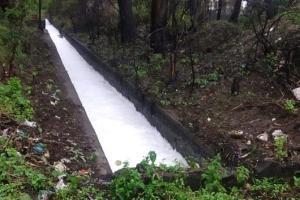Formed with experts after the incident of intense smell that affected many in the suburbs recently, it will meet today to discuss tackling such a situation again

Picture courtesy/Anamika Gharat
The source of the intense smell that thousands were affected by on the night of September 19 is still untraced, but a committee formed to study the incident, will suggest various measures to be taken in case something like it happens again. A meeting will be held today to discuss the measures, one of which is upgrading the Air Quality Index system, or providing hand held devices to the authorities to detect such non-toxic gases.
ADVERTISEMENT
Committee comprises
Additional Municipal Commissioner Dr Ashwini Joshi held a meeting on September 22 to discuss more than a hundred complaints about the gas smell. During the meeting, a committee comprising representatives of the Brihanmumbai Municipal Corporation's (BMC) Disaster Management Cell, Mumbai Fire Brigade, Mumbai Police, Rashtriya Chemical Fertilisers, Directorate of Industrial Safety and Health, Mahanagar Gas Ltd, BPCL and HPCL was formed. While the gas vanished within minutes, it wasn't detected in the AQI system. It was non-toxic as no one was admitted in hospitals due to nausea, vomiting or dizziness. The authorities, however, want to upgrade the system so they can tackle such a situation in future, and hence will meet to discuss measures for the same.
The city has seven AQI centres monitored by the BMC and India Meteorological Department (IMD) where sulphur oxide (SOx), nitrogen oxide (NOx), carbon oxide (COx) and Particulate Matter (PM10) can be detected. But the system doesn't measure methane or mercaptan-like gases which can be a source of such smell. "These gases are non-toxic so until now they were not included in AQI ratio. But after the incident, maybe it would be useful to track them on the system, or use another instrument to detect them," said a member of the committee.
Tracking the gas
There are a few possibilities of the smell. A committee member said that as the complaints came from the Eastern suburbs and then from Western suburbs, the odour could have come from the Kanjurmarg dumping ground. Methane, which is emitted from the dumping ground, mixed with hydrogen sulphide gives a rotten eggs-like smell. But the winds came from the Northeast and the wind speed was merely 3 to 4 km ph.
Another possibility is that the odour was of domestic gas. An assumption is that a tanker carrying Piped Natural Gas (PNG) had a leakage while moving from the Eastern to the Western suburbs, said a committee member. The first call was from Chembur at 7.50 pm and the calls kept coming till 9 pm. After that around 10.20 pm, complaints started from Vile Parle and the Western suburbs and went on till 11 pm. "But there was huge traffic and if the vehicle had a leakage, those in the other vehicles could have smelt it," said a committee member.
PNG is a composition of 95 per cent methane and hydrocarbons. Methane has no odour, so a chemical odourant called mercaptan is added to it so it is easy to detect leakage. Natural gas is non-toxic and lighter than air, so it dissipates quickly in the air. But there were clouds and so the gas got trapped in the lower level of air.
Catch up on all the latest Mumbai news, crime news, current affairs, and also a complete guide on Mumbai from food to things to do and events across the city here. Also download the new mid-day Android and iOS apps to get latest updates
 Subscribe today by clicking the link and stay updated with the latest news!" Click here!
Subscribe today by clicking the link and stay updated with the latest news!" Click here!






